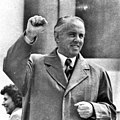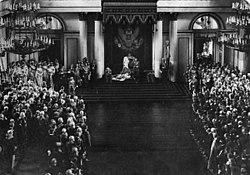Marxism–Leninism
Marxism–Leninism was practiced by the Soviet Union (USSR) after the Bolshevik Revolution. It was also practiced by the Stalinists in the USSR.[1]
The purpose of Marxism–Leninism is to turn a capitalist state into a socialist state. This is done by a revolution by the proletariat to overthrow the old government. The new government then creates a "dictatorship of the proletariat". This new government leads the country based on democratic centralism.[2][3]
The communist party is supposed to lead society from capitalism to socialism. According to ML, socialism was more "advanced" than capitalism, but communism would be more "advanced" than socialism. Indeed, ML is supposed to provide only a first step: from capitalism to socialism, on the way to a communist society with no class or state..
Today, the only remaining countries that claim adherence to Marxism–Leninism are: China, Cuba, Vietnam, and Laos, with North Korea moving to its own political philosophy, Juche, though the ideology was also influenced by Marxism–Leninism.
Lenin introduced the NEP in 1921 because Russia was in a state of collapse.
Beliefs
Marxism–Leninism is an extension of Leninism. It developed as a form of Marxism with adaptations from the works and theories of Vladimir Lenin and Joseph Stalin. Mao Zedong has also made contributions to Marxism–Leninism through Maoism.[4]
Marxism–Leninism Media
Leon Trotsky exhorting Red Army soldiers in the Polish–Soviet War
Mao Zedong with Anna Louise Strong, the American journalist who reported and explained the Chinese Communist Revolution to the West
Enver Hoxha, who led the Sino-Albanian split in the 1970s and whose anti-revisionist followers led to the development of Hoxhaism
Stéphane Courtois, one of the authors of The Black Book of Communism
Vladimir Lenin, who led the Bolshevik faction within the Russian Social Democratic Labour Party
Tsar Nicholas II addressing the two chambers of the Duma at the Winter Palace after the failed 1905 Russian Revolution which exiled Lenin from Imperial Russia to Switzerland
From 5 to 12 January 1919, the Spartacist uprising in the Weimar Republic featured urban warfare between the Communist Party of Germany (KPD) and anti-communist Freikorps units called in by the German government led by the Social Democratic Party of Germany (SPD).
Béla Kun, leader of the Hungarian Soviet Republic, speaks to supporters during the 1919 Hungarian Revolution.
References
- ↑ Dictionary of Historical Terms (1998) Second Edition, Chris Cook, Ed., pp. 221–222, p. 305.
- ↑ Dictionary of Historical Terms (1998) Second Edition, Chris Cook, Ed., pp. 221–222.
- ↑ Albert, Michael; Hahnel, Robin. Socialism Today and Tomorrow. Boston, Massachusetts, USA: South End Press, 1981. pp. 24–25.
- ↑ "Marxist-Leninist Revolutionary Theory". www.marxists.org. Retrieved 2022-04-03.











